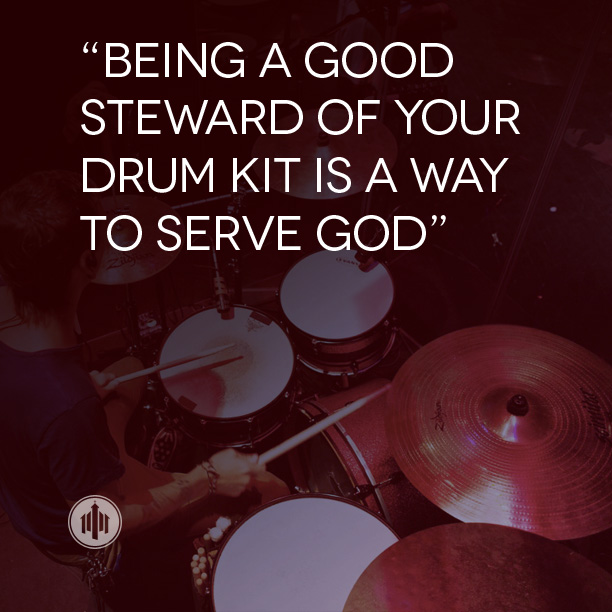
One of the things I am frequently asked about when I’m playing a show, doing a clinic, or just filling in at someone’s church is, “How should we tune our drums?” The more churches and drummers that I’m around, the more I realize that very few people feel confident in tuning drums.
In most worship settings I find a kit that is mic’d behind a shield or total enclosure. If the kit is un-mic’d and has no shield, I would tune the drums a little higher in pitch so that they can project in a room (even a small one). If the kit is shielded, then I always go for the best tone I can get out of each individual drum.
The first thing to consider is selecting the right drumhead for each drum. This can obviously be dictated by a worship budget, but as a general rule I would make it a priority to change the tom heads at least once a year. It would be best to change the snare head quarterly, and the kick head as needed. If you have a kit being used for 3-4 services a weekend plus rehearsals, then heads may need to be changed more often. I frequently play on church kits with heads that are years old and that’s not ok! When a worship pastor asks me why their $5,000 DW kit doesn’t sound good, I almost always suggest new heads.
TUNING PROCESS
Once you put a new head on the drum, push it down in the middle to help seat it on the drum. Put the hoop back on, and tighten the ten lugs by hand until they are finger tight. Then, take a drum key and start tightening one lug at a time. Most people suggest moving in a figure eight pattern back and forth across the drum to eliminate wrinkles. Try and get each lug to the same pitch. Strike an inch or two from each lug with your finger, or a stick, to hear the pitch. You will have to keep going back and forth to get all the lugs even. If the snare is in tune, it shouldn’t have any crazy overtones. To me, a good snare drum sound still has a little bit of ring in it, so don’t be scared of that. This is all up to personal taste of course, but a super dry drum may sound almost dead out front. Many churches tape up their heads so much that everything sounds totally dead.
If your drum is ringing too long you can add Moongel, Drumtacs, or Drumdots. Or, good old-fashioned gaff tape will work fine to cut down on ringing. But, I strongly advise you to tune first. Most people start taping/gelling right away and never get a good tone. A dead drum that is out of tune still sounds poor. I prefer to tune well and use no tape. If a drum is problematic or buzzes a lot, try a thicker head, like a 2-ply. A good option is the Evans HD, which also has an overtone ring. Remo’s Emperor X is also a great head for drums that need muffling. You also need to consider how hard your drummers are playing. If you buy a super thin head and have metal guys bashing it for 3-hour rehearsals, the head isn’t going to last.
As a general rule, I would suggest not cranking the snare drum up as tight as it goes. Almost every kid does this (myself included) because it feels good to play, and a tight head is really sensitive. Tuning it this tight is going to make it so high-pitched out front that it’s hard to turn down in the mix. Also, if you tune super low and muddy, the drum will likely buzz and need a lot of tape. A super low-tuned drum can start to sound like a cardboard box, which isn’t pleasant either. Make sure the snare wires aren’t so tight as to choke the drum itself. Sometimes people fear any buzz and kill the drum sound by over-tightening. I also suggest getting Lug Locks for the snare drum; otherwise, you will likely have the lugs near your hand coming loose throughout services. I put Lug Locks on all of my snare drums, every lug, top and bottom.

KICK DRUM
The kick drum should be set up to fit into the style of music being played, and most modern worship settings call for a punchy kick drum. For heads, I suggest an Evans EMAD Heavyweight, an Aquarian Super-kick 2, or a Remo Powerstroke Pro. There are tons of options but I like that all of these have an external muffling ring and are easier to change. I suggest a light pillow inside, which most companies make (DW and Evans are the most popular). I put a pillow in, touching both the batter and resonant head inside. The kick head can be tuned to almost any tension, but I suggest trying to get both heads on evenly and tighten past the floppy point. Then, try and tune each lug to the same pitch. I prefer a KickPort in my front head to accentuate a little more of the attack and cut some of the ringing frequencies. I would also suggest a port in the front kick head to allow either a mic to be able to go in partially, or an internal mic to be used. The kick drum is the most forgiving because it has a pillow and should ring the least.
SNARE DRUM
Next, let’s move on to the snare drum. This is the most important part of the kit, because it’s the drum that is heard the most. I own several snares for different styles and applications, but you just need one that sounds good. A metal drum will ring longer and likely need some muffling, and a wood drum may be drier. A thinner-shelled drum will be more high pitched, and potentially more piercing in sound; whereas a deeper drum will have a fatter tone but could be floppy. If your church kit has a shallow snare (like a piccolo), I would suggest a 2-ply head, and would not crank up the tuning too much. Similarly, if you have an 8×14 maple snare, I would not tune it too low because it will sound pretty muddy. Standard snare sizes are 6.5×14, and 5.5×14. 5-inch depth is also common on a lot of vintage snares. Most modern kits come with a snare in one of these three sizes. For most snare drums, I prefer a head with a dot of some kind for muffling and added durability. My favorite is the Evans Power Center Reverse Dot, though Remo’s Controlled Sound Dot is also a great option.
TOMS
Toms can be the hardest drums to keep sounding good. The kick can go weeks or months with no tuning and still sound huge. The snare can be tweaked every service, and most drummers work on this because it gets so much playing time. However, many drummers freak out over tuning toms. Again, I would start by looking at the shell material, the style of music, and the mic situation. Most modern worship has big toms that are fat and punchy, like rock music. In my early days, it was only in songs like “Better is One Day” that you might hear the toms. These days you can hear toms on almost every Hillsong power ballad, and toms are much more central to the sound of modern worship.
I suggest 2-ply heads for toms, as they will last longer and control some overtones. Most rock drum sounds have 2-ply heads and tune the toms low, while most jazz drums use 1-ply heads and tune higher. Use the same formula as the snare drum with each head. It takes time and you can’t rush this! If you are changing all the heads, don’t try and knock it out ten minutes before rehearsal. I would give it an hour if you aren’t used to doing it. I like low sounding toms, but “just above floppy” isn’t a pitch. If they are barely finger tight, they will sound like rubber out front.
Tom heads come coated or clear, and both sound good. If your drums are un-mic’d, I would suggest using clear for a little more volume. Mic’d up in a shield, both coated or clear will work well. I’d suggest Evans G2 Coated or Remo Coated Emperors, and these also sound great in the clear version. Both companies also make other heads with some control, like Evans EC2, which has a control ring around the outside. The smallest tom will typically be easiest to tune. For the floor tom, I suggest pushing your finger down in the middle of the drum to take away overtones while striking near each lug.
Toms can also use tape or gel. Again, I try and dial mine in without extra stuff, but sometimes it’s just necessary. This is especially true if I’m jumping on a church kit or one that I don’t play all the time. The bottom head is also a major factor on drums. These should be changed once a year, as they also dull over time. My own personal trick is to use a 2-ply on the bottom of a floor tom as well as the top to eliminate ring, but that is a bit unconventional. Tune the bottom head a little higher than the top to make the drum ring more, or lower to ring less. Basically, you need to check the bottom head every time a tom is acting funny or won’t quit ringing with weird overtones. Check and make sure there isn’t a loose lug somewhere, as the bottom ones drop in pitch and are usually checked less frequently.
Finally, take the shield down (if you can) when changing heads on the whole kit. I find that being cramped inside always makes me cut corners and do a lesser job. It’s always too tight in there and hard to move around to adjust the drums. The drums will always be easier to get sounding best in a big room than a tiny, shielded area. If they are tuned up and sound good ten feet away, they will likely sound good under the mics. Some people tune the tom intervals to perfect fourths or fifths. This technique is great but doesn’t work with every kit, especially lower budget ones. My personal tuning style is to get every drum sounding the best it can, and resonating as long as the others. As long as the pitches are descending evenly, it works great.
I think tuning should be taught early on, just like holding your sticks or learning paradiddles. As a kid, I was afraid to try anything because I didn’t want to mess up my drums. It is important to experiment with tuning and encourage your drummers to do so also. Too many drummers don’t learn this skill, and say they will rely on the soundmen to fix any sound issues. Soundmen then get frustrated because the kit sounds horrible. Get the kit sounding great before the mics are on, and they will sound so much better out front! Work within your budget, but try and make it a priority to get a decent kit and to update the heads regularly. Being a good steward of the drum kit you use is another way we can serve God, our worship band, and will help our congregation have a better worship experience.

